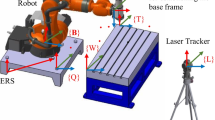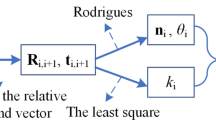Abstract
The existing automatic inspection system employed for the quality assessment in the manufacturing of automotive parts, comprising industrial robots and sensors, has a low absolute positioning accuracy. Therefore, a new method based on an optimally pruned extreme learning machine algorithm is proposed to compensate for the absolute positional errors. This algorithm is applied to the positional error compensation of a robot end-effector by mapping the robot target position to the computed position. We selected sampling points in the robot motion space to establish an error prediction model and used the trained model to predict the error at the test points. Experiments were carried out to verify the effectiveness of the proposed method in measuring the robot positional errors in the x, y, and z axes and the total absolute accuracy. The maximum absolute positional error reduced by 78.3% from 1.472 to 0.319 mm, and the average positional error reduced by 84.5% from 1.235 to 0.191 mm. A robot was made to move along a predetermined trajectory at different speeds with improved positioning accuracy. A comparison experiment was performed to validate the accuracy and superiority of the method. The experimental results showed that the proposed method could significantly improve the positional accuracy of the robotic inspection system and that the method represents an effective and convenient technique for robot calibration in workshops.














Similar content being viewed by others
References
Chen Y, Dong F (2013) Robot machining: recent development and future research issues. The Int J Adv Manuf Technol 66(9–12):1489–1497
Guo Y, Yin S, Ren Y et al (2015) A multilevel calibration technique for an industrial robot with parallelogram mechanism. Precis Eng 40:261–272
Summers M (2005) Robot capability test and development of industrial robot positioning system for the aerospace industry. SAE Tran 114(1):1108–1118
Gang Chen, Tong Li, Ming Chu et al (2014) Review on kinematics calibration technology of serial robots. Int J Precis Eng Manuf 15(8):1759–1774
Liu Z, Zhao ZD, Xie Y et al (2015) Kinematic calibration and compensation for a robot with structural deformation. Robot 37(3):376–384
Denavit J, Hartenberg RS (1955) A kinematic notation for lower-pair mechanisms based on matrices. J Appl Mech 22:215–221
Gatti G, Danieli G (2007) A practical approach to compensate for geometric errors in measuring arms: application to a six-degree-of-freedom kinematic structure. Meas Sci Technol 19(1):1–12
Stone HW, Sanderson AC (1988) Statistical performance evaluation of the S-model arm signature identification technique. IEEE International Conference on Robotics and Automation, pp 939–946
Rosvold JM, Atarod M, Frank CB et al (2015) An instrumented spatial linkage for measuring knee joint kinematics[J]. Knee 23(1):43–48
Li C, Yuanqing W, Lowe H et al (2016) POE-based robot kinematic calibration using axis configuration space and the adjoint error model [J]. IEEE Trans Robot 32(5):1264–1279
Zak G, Benhabib B, Fenton R, Saban I (1994) Application of the weighted least squares parameter estimation method to the robot calibration. J Mech Des 116(3):890–893
Motta JMST (2001) Robot calibration using a 3D vision-based measurement system with a single camera. Robot Comput Integrat Manuf 17(6):487–497
Nubiola A, Bonev I (2013) Absolute calibration of an ABB IRB 1600 robot using a laser tracker. Robot Comput Integr Manuf 29(1):236–245
Nguyen H, Zhou J, Kang H (2015) A calibration method for enhancing robot accuracy through integration of an extended Kalman filter algorithm and an artificial neural network. Neurocomputing 151(P3):996–1005
Render JM, Rossignal E, Becquet M, Hanus R (1991) Kinematic calibration and geometrical parameter identification for robots. IEEE Trans Robot Autom 7(6):721–732
Omodei A, Legnani G, Adamini R (2000) Three methodologies for the calibration of industrial manipulators: experimental results on a SCARA robots. J Robot Syst 17(6):291–307
Bai Y (2007) On the comparison of model-based and modeless robotic calibration based on a fuzzy interpolation method. Int J Adv Manuf Technol 31(11–12):1243–1250
Alici G, Shirinzadeh B (2005) A systematic technique to estimate positioning errors for robot accuracy improvement using laser interferometry based sensing. Mech Mach Theory 40:879–906
Zhou W, Liao W, Tian W (2013) Theory and experiment of industrial robot accuracy compensation method based on Spatial Interpolation. J Mech Eng 49(3):42–48
Cai Y, Yuan P, Shi Z (2019) Application of Universal Kriging for Calibrating offline-programming Industrial Robots. J Intell Rob Syst 94:339–348
Chen D, Yuan P et al (2018) A compensation method for enhancing aviation drilling robot accuracy based on Co-Kriging. Int J Precis Eng Manuf 19(8):1133–1142
Rui MA, Yushu L, Yanhui D (2004) An intrusion detection method based on neural network expert system. Comput Eng Appl 40:151–153
Yuan P, Chen D, Wang T et al (2018) A compensation method based on extreme learning machine to enhance absolute position accuracy for aviation drilling robot. Adv Mech Eng 10(3):1–11
Longfei W, Xu L, Liyan Z et al (2018) Analysis of the Positioning error of Industrial robots and accuracy compensation based on ELM algorithm. ROBOT 40(6):843–851
Efron B, Hastie T, Johnstone I, Tibshirani R (2004) Least angle regression. Statist 32(2):407–499
Boyd S, Vandenberghe L (2004) Convex optimization[M]. Cambridge University Press, New York, USA
Huang GB, Zhu QY, Siew CK (2006) Extreme learning machine: Theory and applications. Neurocomputing 70:489–501
Acknowledgements
This research was sponsored by the National Key Research and Development Project [No. 2018YFB1701002] and Research and Development plan for key areas in Guangdong Province [No. 2019B090919001].
Author information
Authors and Affiliations
Corresponding author
Additional information
Technical Editor: Rogério Sales Gonçalves.
Publisher's Note
Springer Nature remains neutral with regard to jurisdictional claims in published maps and institutional affiliations.
Rights and permissions
About this article
Cite this article
Chen, G., Yang, J., Xiang, H. et al. New positional accuracy calibration method for an autonomous robotic inspection system. J Braz. Soc. Mech. Sci. Eng. 44, 177 (2022). https://doi.org/10.1007/s40430-022-03487-x
Received:
Accepted:
Published:
DOI: https://doi.org/10.1007/s40430-022-03487-x




